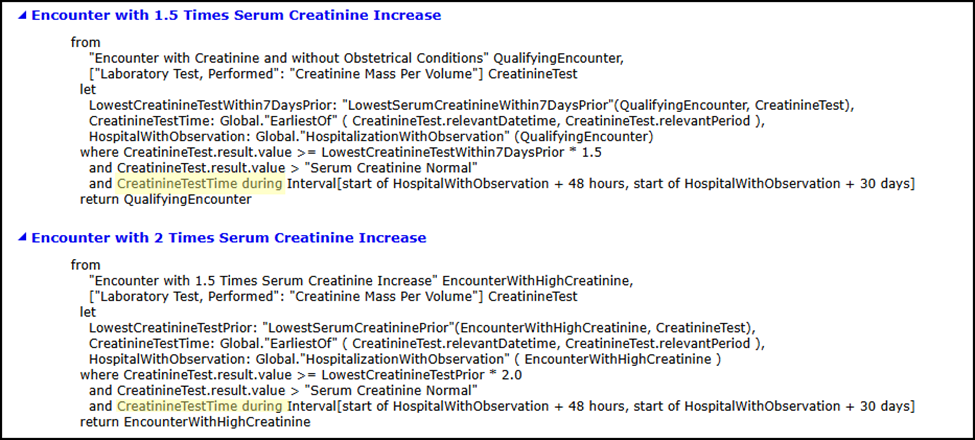Thank you for your inquiry regarding CMS832v3, Hospital Harm – Acute Kidney Injury. The numerator action, AKI stage 2 or greater, is defined as a “subsequent increase in serum creatinine value at least 2 times higher than the lowest serum creatinine value, and the increased value is greater than the highest sex-specific normal value for serum creatinine.” The numerator logic was updated in v3 to correct a known issue (
https://oncprojectracking.healthit.gov/support/projects/EKI/issues/EKI-35?filter=allopenissues), in which the v2 measure logic only evaluated the highest and lowest serum creatinine values obtained during the encounter, to determine if there is evidence of AKI stage 2 or greater. The v3 measure logic, specifically the definitions ‘Encounter with 1.5 Times Serum Creatinine Increase’ and ‘Encounter with 2 Times Serum Creatinine Increase’ were updated to evaluate all creatinine values within an encounter for evidence of AKI.
It is important to note that in v3, LowCreatineTest and HighCreatineTest were replaced with logic that evaluates all serum creatinine results, ‘CreatinineTest.result.value’, between 48 hours after the start of the hospitalization and either discharge or 30 days after the start of the hospitalization, whichever is sooner to determine if the following criteria are met:'
‘Encounter with 1.5 Times Serum Creatinine Increase’
Increased creatinine value (CreatineTest.result.value) is greater or equal to the lowest value within the 7 days prior (LowestCreatinineTestWithin7DaysPrior), multiplied by 1.5
where CreatetineTest.result.value >= LowestCreatinineTestWithin7DaysPrior * 1.5
and CreatinineTest.result.value > "Serum Creatinine Normal"
and CreatinineTestTime during Interval[start of HospitalWithObservation + 48 hours, start of HospitalWithObservation + 30 days]
return QualifyingEncounter
‘Encounter with 2 Times Serum Creatinine Increase’
Increased creatinine value is greater or equal to the lowest prior value (at any prior time) during the encounter, multiplied by 2
where CreatinineTest.result.value >= LowestCreatinineTestPrior * 2.0
and CreatinineTest.result.value > "Serum Creatinine Normal"
and CreatinineTestTime during Interval[start of HospitalWithObservation + 48 hours, start of HospitalWithObservation + 30 days]
return EncounterWithHighCreatinine
In response to your concern regarding the removal of ‘duringHospitalizationWithObservation’ from the numerator definitions ‘Encounter with 1.5 Times Serum Creatinine Increase’ and ‘Encounter with 2 Times Serum Creatinine Increase’: It is not accurate that the only remaining criterion is that the ‘CreatinineTest’ must fall within the interval between 48 hours to 30 days after the start of the encounter. The text ‘duringHospitalizationWithObservation’ was removed from the numerator definitions in v3 due to redundancy. A ‘CreatinineTest’ must already be performed during “Global.HospitalizationWithObservation” (Qualifying Encounter), specifically during the interval of start of HospitalizationPeriod + 48 hours, to the end of the hospitalization. Please reference definition ‘Inpatient Encounter with Creatinine’ below:
Inpatient Encounter with Creatinine
from
"Encounter with Age 18 and Length of Stay 48 Hours or More and Male or Female Sex" Encounter48Hours,
["Laboratory Test, Performed": "Creatinine Mass Per Volume"] CreatinineTest
let HospitalizationPeriod: Global."HospitalizationWithObservation" ( Encounter48Hours ),
CreatinineTestTime: Global."EarliestOf" ( CreatinineTest.relevantDatetime, CreatinineTest.relevantPeriod )
where CreatinineTest.result is not null
and CreatinineTestTime during Interval[start of HospitalizationPeriod + 48 hours, end of HospitalizationPeriod]
return Encounter48Hours
The logic would capture creatine tests that represent a 2 times increase in serum creatinine, even in scenarios where the patient’s inpatient encounter was less than 30 days.
Hosp Inpt eCQMs - Hospital Inpatient eCQMs
Moderate


